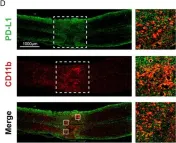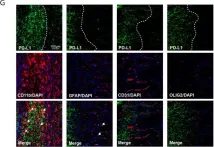Psoriasis is a chronic inflammatory skin disease characterised by inflammatory cell infiltration, keratinocyte hyperproliferation and increased neovascularization. Despite extensive research, the precise mechanisms underlying psoriasis pathology and treatment strategies remain unclear because of a complex aetiology and disease progression. Hence, in this study, we aimed to identify potential therapeutic targets for psoriasis and explore their effects on disease progression. We observed that G protein-coupled receptor LGR4 attenuates psoriasis progression. Bioinformatics analysis of publicly available clinical data revealed lower LGR4 expression in the skin lesions of patients with psoriasis than in their non-lesioned skin. Both in vitro (HaCaT cell) and in vivo (mouse) models confirmed this phenomenon. The Lgr4-knockout mouse model further confirmed that LGR4 plays a positive role in psoriasis progression. Specifically, Lgr4 knockout promoted the secretion of inflammatory factors, accumulation of local immunocyte infiltration in skin lesions, and keratinocyte proliferation. In conclusion, we demonstrated that LGR4 is critical to limiting psoriasis progression, suggesting that it is a viable target for the clinical management of this skin condition.
© 2024 John Wiley & Sons Ltd.
Product Citations: 29
In Immunology on 1 February 2025 by Xue, M., Yang, R., et al.
-
Immunology and Microbiology
In Brain Communications on 10 October 2024 by Zhou, T., Gao, Y., et al.
Mounting evidence indicates the involvement of peripheral immunity in the regulation of brain function, influencing aspects such as neuronal development, emotion, and cognitive abilities. Previous studies from our laboratory have revealed that neonatal hepatitis B vaccination can downregulate hippocampal neurogenesis, synaptic plasticity and spatial learning memory. In the current post-epidemic era characterized by universal vaccination, understanding the impact of acquired immunity on neuronal function and neuropsychiatric disorders, along with exploring potential underlying mechanisms, becomes imperative. We employed hepatitis B vaccine-induced CD3 positive T cells in immunodeficient mice to investigate the key mechanisms through which T cell subsets modulate hippocampal neurogenesis and anxiety-like behaviours. Our data revealed that mice receiving hepatitis B vaccine-induced T cells exhibited heightened anxiety and decreased hippocampal cell proliferation compared to those receiving phosphate-buffered saline-T cells or wild-type mice. Importantly, these changes were predominantly mediated by infiltrated CD8+ T cells into the brain, rather than CD4+ T cells. Transcriptome profiling of CD8+ T cells unveiled that C-X-C motif chemokine receptor 6 positive (CXCR6+) CD8+ T cells were recruited into the brain through microglial and astrocyte-derived C-X-C motif chemokine ligand 16 (CXCL16). This recruitment process impaired neurogenesis and induced anxiety-like behaviour via tumour necrosis factor-α-dependent mechanisms. Our findings highlight the role of glial cell derived CXCL16 in mediating the recruitment of CXCR6+CD8+ T cell subsets into the brain. This mechanism represents a potential avenue for modulating hippocampal neurogenesis and emotion-related behaviours after hepatitis B vaccination.
© The Author(s) 2024. Published by Oxford University Press on behalf of the Guarantors of Brain.
-
Immunology and Microbiology
-
Neuroscience
In Science Advances on 13 September 2024 by Chen, D., Zhou, Z., et al.
Current pharmacotherapy remains futile in acute alveolar inflammation induced by Gram-negative bacteria (GNB), eliciting consequent respiratory failure. The release of lipid polysaccharides after antibiotic treatment and subsequent progress of proinflammatory cascade highlights the necessity to apply effective inflammation management simultaneously. This work describes modular self-assembling peptides for rapid anti-inflammatory programming (SPRAY) to form nanoparticles targeting macrophage specifically, having anti-inflammation and bactericidal functions synchronously. SPRAY nanoparticles accelerate the self-delivery process in macrophages via lysosomal membrane permeabilization, maintaining anti-inflammatory programming in macrophages with efficacy close to T helper 2 cytokines. By pulmonary deposition, SPRAY nanoparticles effectively suppress inflammatory infiltration and promote alveoli regeneration in murine aseptic acute lung injury. Moreover, SPRAY nanoparticles efficiently eradicate multidrug-resistant GNB in alveoli by disrupting bacterial membrane. The universal molecular design of SPRAY nanoparticles provides a robust and clinically unseen local strategy in reverse acute inflammation featured by a high accumulation of proinflammatory cellularity and drug-resistant bacteria.
-
Immunology and Microbiology
Gut-derived memory γδ T17 cells exacerbate sepsis-induced acute lung injury in mice.
In Nature Communications on 7 August 2024 by Xie, B., Wang, M., et al.
Sepsis is a critical global health concern linked to high mortality rates, often due to acute lung injury (ALI)/acute respiratory distress syndrome (ARDS). While the gut-lung axis involvement in ALI is recognized, direct migration of gut immune cells to the lung remains unclear. Our study reveals sepsis-induced migration of γδ T17 cells from the small intestine to the lung, triggering an IL-17A-dominated inflammatory response in mice. Wnt signaling activation in alveolar macrophages drives CCL1 upregulation, facilitating γδ T17 cell migration. CD44+ Ly6C- IL-7Rhigh CD8low cells are the primary migratory subtype exacerbating ALI. Esketamine attenuates ALI by inhibiting pulmonary Wnt/β-catenin signaling-mediated migration. This work underscores the pivotal role of direct gut-to-lung memory γδ T17 cell migration in septic ALI and clarifies the importance of localized IL-17A elevation in the lung.
© 2024. The Author(s).
-
FC/FACS
Cryptotanshinone promotes brown fat activity by AMPK activation to inhibit obesity.
In Nutrition Research and Practice on 1 August 2024 by Ni, J., Ye, A., et al.
Activating brown adipose tissue (BAT) and browning of white adipose tissue (WAT) can protect against obesity and obesity-related metabolic conditions. Cryptotanshinone (CT) regulates lipid metabolism and significantly ameliorates insulin resistance. Adenosine-5'-monophosphate (AMP)-activated protein kinase (AMPK), a receptor for cellular energy metabolism, is believed to regulate brown fat activity in humans.
The in vivo study included high-fat-fed obese mice administered orally 200/400 mg/kg/d CT. They were evaluated through weight measurement, the intraperitoneal glucose tolerance test (IPGTT), intraperitoneal insulin tolerance test (IPITT), cold stimulation test, serum lipid (total cholesterol, triglycerides, and low-density lipoprotein) measurement, hematoxylin and eosin staining, and immunohistochemistry. Furthermore, the in vitro study investigated primary adipose mesenchymal stem cells (MSCs) with incubation of CT and AMPK agonists (acadesine)/inhibitor (Compound C). Cells were evaluated using Oil Red O staining, Alizarin red staining, flow cytometry, and immunofluorescence staining to identify and observe the osteogenic versus adipogenic differentiation. Quantitative real-time polymerase chain reaction and the Western blot were used to observe related gene expression.
In the diet-induced obesity mouse model mice CT suppressed body weight, food intake, glucose levels in the IPGTT and IPTT, serum lipids, the volume of adipose tissue, and increased thermogenesis, uncoupling protein 1, and the AMPK pathway expression. In the in vitro study, CT prevented the formation of lipid droplets from MSCs while activating brown genes and the AMPK pathway. AMPK activator enhanced CT's effects, while the AMPK inhibitor reversed the effects of CT.
CT promotes adipose tissue browning to increase body thermogenesis and reduce obesity by activating the AMPK pathway. This study provides an experimental foundation for the use of CT in obesity treatment.
©2024 The Korean Nutrition Society and the Korean Society of Community Nutrition.
-
FC/FACS
In Front Immunol on 4 May 2021 by Kong, F., Sun, K., et al.
Fig.1.D

-
IF
-
Mus musculus (House mouse)
Collected and cropped from Front Immunol by CiteAb, provided under a CC-BY license
Image 1 of 2
In Front Immunol on 4 May 2021 by Kong, F., Sun, K., et al.
Fig.1.G

-
IHC-IF
-
Mus musculus (House mouse)
Collected and cropped from Front Immunol by CiteAb, provided under a CC-BY license
Image 1 of 2

